HIV: What's Next
Six Scientists Share Their Work
Where antiretroviral drugs are taken as prescribed, HIV/AIDS has passed from a crisis to a manageable chronic disease. Researchers are deeply engaged with the next set of questions: How can HIV patients have a better quality of life? What aging conditions or diseases might they be more susceptible to as a result of living with the virus? Are there better treatments that might involve fewer side effects, or that can be used if the existing ones are no longer effective? Can a vaccine be developed that will conquer this health threat once and for all?
The Drive to Know
For Peter Gaskill, PhD, HIV research will always be in some way personal. The assistant professor in the Department of Pharmacology & Physiology funneled his passion for science into this particular subject matter in large part because his own mother was diagnosed with HIV in the heart of the AIDS panic of the early 1990s.
"My parents found out because of a blood test anomaly, which was reported to them through a letter from their insurance company," he says. "I was a teenager at the time. There was no internet and I didn't know anything about HIV or AIDS." His mother's illness had a profound impact on Gaskill's life in many ways, and her death, just before he graduated from college, drove home the realization that far too little was understood about HIV.
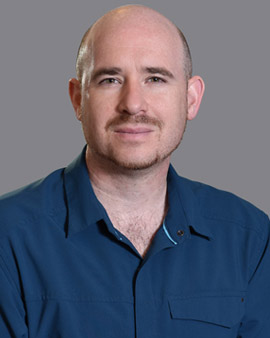
Peter Gaskill, PhD
"She was taking about 40 different medications, including the earliest antiretrovirals, and the medications were making her quality of life worse," Gaskill says. "When she went into septic shock, the doctors were telling us in so many words that there was nothing anyone could do. I remember thinking I will never not know again."
As a researcher, Gaskill homed in on the neuroHIV field, which is trying to understand the pathology underlying the cognitive and behavioral impact of HIV infection in the brain. The range of conditions caused by HIV damage to the central and peripheral nervous systems can include vacuolar myelopathy, sensory neuropathy, anxiety and depression, and dementia. "I was interested in the physical changes that cause neurocognitive issues. In today's epidemic, where many people are on antiretroviral therapy, we've found that a lot of the physical changes we've seen don't always correlate with the cognitive or behavioral categories we've created. It makes it challenging to design targeted therapies, because it is hard to solve a problem if you don't know the underlying cause."
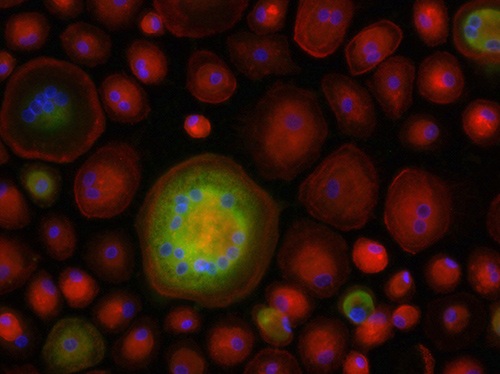
Macrophages being infected with HIV in the presence of dopamine, five days after start of infection. Actin, a cytoskeletal protein, is labeled in red; cell nuclei, in blue; and HIV (the p24 protein), in green.
The Gaskill Lab is currently investigating the impact of drug abuse on HIV-associated neurocognitive disorders, particularly as it relates to dopamine-mediated changes in macrophages — cells that play a central role in HIV neuropathogenesis. A large number of people with HIV suffer from substance use disorders, which have been linked to acquiring the virus, but which may also change the course of the infection itself. Gaskill and his collaborators are looking at the mechanisms inside the human cell after dopamine or HIV binds to its surface. This research also applies to legal therapeutics such as antidepressants and their relationship with neuroimmune function.
"People are living longer with HIV, but that longevity creates a series of new problems," Gaskill says. "People are depressed. They have diabetes, gastrointestinal issues, cardiovascular problems and neurocognitive effects as well. The treatments themselves can cause these issues, and then there are comorbid factors like drug abuse, which also contribute to problems. If we want to treat people who use drugs of abuse, or people who have Alzheimer's or Parkinson's disease, we have to come up with better therapeutics to do so. There's a lot more we still need to know."
Closing the Door on HIV
Professor of biochemistry and molecular biology Irwin Chaiken, PhD, wants to stop HIV before it can take hold in the body. As a protein scientist, he focuses on the entry mechanism of the virus into cells.
"I realized that if we could reveal the fundamental properties of the virus protein machine, we might figure out a way to stop the entry itself," he says.
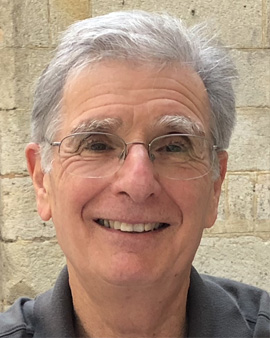
Irwin Chaiken, PhD
That has meant defining the HIV envelope surface protein, known as Env. When it interacts with cells, the Env changes shape so that it anchors on both the virus and the cell. Chaiken and a multi-institutional cohort of collaborators, funded by the National Institutes of Health, have been seeking ways to hijack entry interactions, including compounds that change the Env's shape and its mechanisms. As the findings have evolved, Chaiken says, so too have the objectives.
"The research field has certainly changed over time. Initially, we were more focused on blockers to stop the infection," he says. "But now there is a very strong push to find a cure and eradicate both the virus and infected cells altogether. Compounds we have found have the potential to be developed for eradication, but we still have a long way to go."
Ultimately Chaiken would like to see translation of mechanistic findings into commercialization projects. To that end, he has formed a team with seed funding from the Coulter-Drexel Translational Research Partnership program, though he doesn't anticipate having a working compound for at least five to 10 years.
"People want a functional or real cure, and there is currently no frontline therapy for HIV that uses the same target we're going after," he says. "If we developed such a compound, it could potentially be used in combination with existing therapies. I don't think we should shy away from finding additional therapeutics, because people can still become resistant to the ones that are out there."
The developments have been exciting and profound. At 76, Chaiken wants to keep on exploring the fundamental questions he's been posing throughout his career.
"The work we've already done could ultimately tell us how to defeat HIV, and that is a very rewarding prospect."
A Bigger Picture
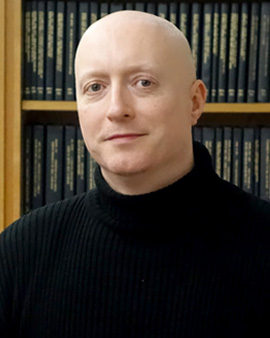
Simon Cocklin, PhD
One reason Simon Cocklin, PhD, enjoys studying HIV is because he sees the virus as a threshold into a world of possibilities. "Every time we learn something, it not only redefines HIV biology, but usually it also has broad implications for biochemistry and biology as a whole," he says.
Today he is an associate professor in the Department of Biochemistry & Molecular Biology, but Cocklin started his career as a postdoctoral student working for Irwin Chaiken. Fascinated by the virus and its ways of evading the immune system, Cocklin was hooked and ended up making HIV a focus of his own research career. The Cocklin Lab is working on a small-molecule inhibitor discovery program with the aim of developing a new class of antiretroviral agents.
"We don't just focus on one target. We have three targets. We have inhibitors that stop the entry of HIV in susceptible cells and target the HIV Env, as well as compounds that target the capsid protein."
Additionally, for the first time in a decade, Cocklin has received significant funding to pursue his passion project. He's targeting the HIV-1 matrix protein, which is fundamental to the life cycle of the virus, and key to the virus's replication.
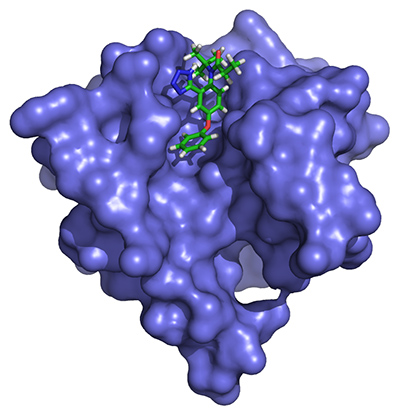
A first-in-class small-molecule inhibitor with a unique mechanism of action has been shown to target the HIV-1 matrix protein in vitro.
"We are the first people to have inhibitors of the matrix protein, whose function is to guide all the components of the virus to the plasma membrane. These are first-in-class compounds, so it's early yet, but we've seen promising results."
The field has changed significantly in the last several years, Cocklin says. Whereas in the past, research may have focused on the virus's enzymes, interest has shifted toward the idea of targeting and inhibiting the structural proteins.
"We now have a battery of 25 inhibitors in the clinic, but the virus adapts and resists them over time. In the absence of a viable vaccine, we have to continually produce new therapeutic targets and make new drugs to continue to provide a good quality of life for patients."
Multipronged Attack
Elias El Haddad, PhD, a professor of medicine in the Division of Infectious Diseases & HIV Medicine, first witnessed people infected with HIV when he was a graduate student conducting research in Lebanon in the 1980s. Before the advent of AZT, the outlook was grim.

Elias El Haddad, PhD
"People knew they were dying — a big community had come to Lebanon from sub-Saharan Africa, where there was no treatment for them," El Haddad says. "It was worse than cancer in how fast it progressed. Today, the picture is so different, but we still need the ultimate cure, which would be a vaccine."
As a researcher, El Haddad takes a cross-disciplinary approach, and his HIV work centers on three distinct projects: vaccine development, cure discovery and basic research about the virus's mechanisms.
"We need to better understand infection, how HIV acts in the body and how the host responds to it," he says. "I have been working in HIV since 2000, and my research has changed in that time, from looking at the pathogenesis of the infection to trying to understand the mechanisms of immune response."
With the help of HIV-infected individuals, specifically the so-called "elite controllers," who have the ability to control virus replication without the need for antiretroviral therapy, El Haddad and his collaborators have been able to study the mechanisms of the host immune response to the virus as it progresses in the body. In identifying a biomarker for central memory T cells and memory B cells, he has uncovered how these patients might naturally keep the virus at bay, with potential implications for immunotherapy treatment targets.
El Haddad's vaccine work has advanced significantly in recent years with a finding published in Nature Medicine, where he and his colleagues described a new subset of T cells, called follicular helper T cells, that is important for humoral immunity and is defective in HIV-infected individuals. More recently, in a study published in Nature Communications, he demonstrated a new molecule called ADA that could be harnessed to target follicular helper T cells and might be used as a target for a novel vaccine.
"There are still many people who are at risk for getting the virus, and a vaccine could prevent this. At the same time, a virus and immunotherapy are not necessarily mutually exclusive. We might be able to use both together."
El Haddad's lab is currently working to develop and test an adjuvant to see whether it can induce or alter the immunoresponse to HIV infection. His latest results will be published in upcoming papers. For now, he finds that emerging discoveries and the commitment of patients keep him optimistic about the future of the field.
"The people who volunteer for research have made our work possible. That motivates me to continue and stay hopeful that this work will eventually have a significant impact."
The Cutting Edge of Treatment
Michael Nonnemacher, PhD, can remember when, as a teenage science geek, he would tell his friends that someday he'd find a cure for AIDS.
"Back in the 1980s and 1990s, we knew so little about the disease, and I was naïve about what it really meant to be able to accomplish such a thing," says the associate professor in Microbiology & Immunology.

Michael Nonnemacher, PhD
As a graduate student at Penn State University, Nonnemacher started working with Brian Wigdahl, PhD, examining how genetic variations of HIV might impact proteins important for the virus's replication in immune cells. When Wigdahl was recruited to Drexel, Nonnemacher went with him.
"My current grant research focuses on seeking diagnostics for neurocognitive impairment, which occurs in about 50 percent of HIV patients," Nonnemacher says. "We think the protein called Tat plays a large role in driving the replication of the virus, and causing neurotoxicity and the pathogenesis seen in the central nervous system."
Through gene sequencing and biostatistics, Nonnemacher and his colleagues Sandhya Kortagere, PhD, and Will Dampier, PhD, can study associated amino acid changes in patients, which they hope will lead to a genetic diagnostic test for neurocognitive impairment.
On another project, with Wigdahl and teams of researchers at Temple University and Case Western Reserve, Nonnemacher is looking at a potential therapeutic solution for HIV that uses leadingedge CRISPR gene-editing technology, developed initially for cancer treatment.
"We are developing guide RNAs with the potential to be broad spectrum, to account for viral quasispecies within and between patients infected with subtype B virus, the most commonly found in the Americas and Europe. If we can edit the HIV genome, cutting it out completely, making the promoter defective, and/or eliminating the proteins necessary for replication, we think this approach can be used as a therapeutic."
While human trials are still a long way away, the application of this technology for HIV could be very promising. Nonnemacher tells his students that they should look outside their own narrow window of research to the larger scientific community, as sometimes the answers might lie beyond their immediate scope. After all, he says, before 2013, gene editing wasn't something he'd ever imagine using. Once he did, however, a new direction for his research, along with new possibilities for actually finding a treatment, suddenly emerged.
"To be where I am now, to be looking at therapeutics and diagnostics, is very exciting and it shows the evolution, what we've learned and just how far we've all come," he says. "Now I'm hopeful that we just might see the light at the end of the tunnel."
Improving Life with HIV
Vanessa Pirrone, PhD '09, was a high school science teacher when she first studied HIV with her students — a formative moment in her decision to go back to school and pursue a research career.
"We read a book about the discovery of the HIV virus in the 1980s, and I found it fascinating — namely, the idea of identifying an infectious disease that is afflicting so many people," says the assistant professor in the Department of Microbiology & Immunology. "I wanted to know how you identify a disease like that, and how you delve deeper to understand the mechanisms at work."
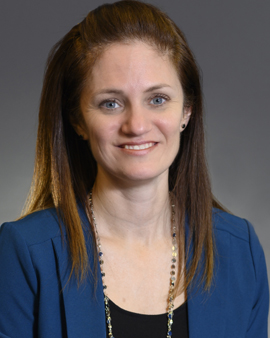
Vanessa Pirrone, PhD
In her collaborative research — funded by NIH, Temple University's Comprehensive HIV Program and the Sidney Kimmel Cancer Center — Pirrone works across a number of different areas, largely focusing on what it means to live with HIV as the first generation grows older with it. With Brian Wigdahl, she studies a local cohort of patients every six months to see how the virus has progressed. The patient cohort includes not just individuals who are aging with HIV, but some older patients who have been newly infected.
"We collect patient blood samples and ask them questions to delve into their clinical and demographic history. This information helps us springboard other research questions," she says. "The studies I'm most interested in have to do with HIV and aging. We're finding out that the aging process for HIV patients is not the same, and we want to understand why."
Some of the conditions HIV patients are developing include osteoporosis and mild, progressive dementia 10 years earlier than the population at large. Forty percent of HIV patients develop cancer, not just AIDS-defining cancers like Kaposi sarcoma, but liver, oral and colon cancer. Pirrone is studying the connections between the diseases, working with both colon and anal cancer patients.
The question Pirrone is raising is whether HIV synergistically accelerates immune system response and thereby accelerates the aging process. Pirrone is now in the process of taking her research from the bedside to the molecular and cellular biology bench, studying the mechanisms that emerge. The goal is to develop therapeutics, screening paradigms and regimens for existing treatments for aging patients.
Working at Drexel, where the HIV research community is richly diverse, has been inspiring. "We have so many research projects and experts across disciplines," she says.
Pirrone still has the same fascination with HIV research that was sparked in her classroom, and she's grateful to be working in a time when she can build on the advances that came before her.
"Our patients know that we might not be able to change anything in their lifetime, but we have the potential to help future generations," she says. "Even if we can't cure patients, we can help them understand their risks and the biomarkers to watch for these diseases. Ten years later — to say I've been able to contribute to the body of research about HIV is an amazing thing."
Back to Top